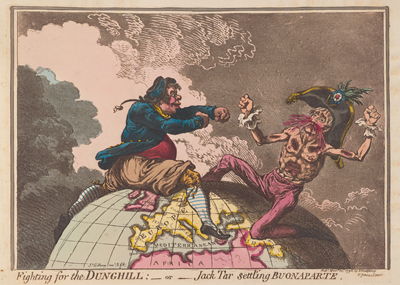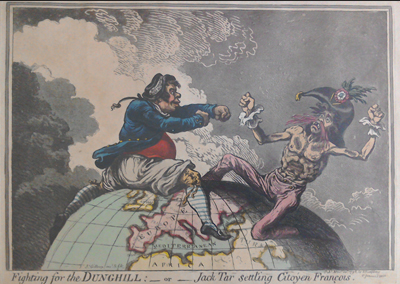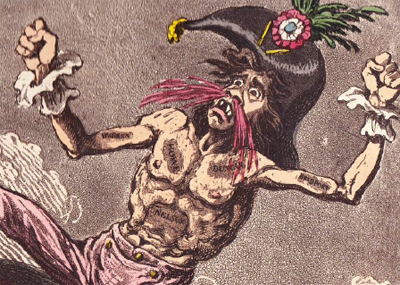Fighting for the Dunghill,
or Jack Tar Settling Buonaparte
This is the second state of a print that started with the title Fighting for the Dunghill, or Jack Tar Settling Citoyen François. Both states were part of a multi-print reaction to Horatio Nelson's astonishing victory over the French fleet at the Battle of the Nile.

[November 20, 1798]
© Beinecke Rare Book and Manuscript Library, Yale University

[November 20, 1798]
© Omek Marks, Private Collection
In the first state of the print, the boxing match for world domination was conceived as a faceoff between the two symbolic representatives of Britain and France: Jack Tar and Citoyen François. In keeping with long-standing national iconography, Britain was represented by a beefy Jack Tar and France by an emaciated and effeminate Citoyen François. The blows delivered by Jack (labeled in this first state) included not only Nelson's victory at the Nile, but earlier major victories by other British Admirals such as Howe, Warren, Bridport, and Duncan.

or Jack Tar Settling Citoyen François
[November 20, 1798]
© Omek Marks, Private Collection
But given Gillray's predisposition to make all satire personal, it is not totally surprising that in the second state he changed the generic Citoyen Francois to the specific individual, Buonaparte. He must have quickly realized and welcomed the growing prominence of Napoleon in the British press. Now he had the opportunity to create another lasting and reusable caricature as he had for Fox, Sheridan, and other major political figures. But as he had done earlier with Fox, Gillray tried a number of versions of Napoleon before he came up with the diminutive, manic "Boney" that is familiar to us from The Hand-Writing upon the Wall (1803), the Maniac Raving's-or-Little Boney in a Strong Fit (1803). It was perhaps only a matter of time before this personalizing tendency reached its logical conclusion in Gillray's most famous print The Plumb Pudding in Danger (1805).

© National Portrait Gallery, London
In 1799, however, without an obviously better alternative, he retained the half-starved and effeminate generic Frenchman for his first image of Bonaparte. But once he had personalized the print by naming Buonaparte, however, he had to cover over most of the labeled bruises from the first state because those British victories did not involve Napoleon. A careful look at the second state shows that he did so in perfunctory fashion, barely scratching over the earlier labels. Thanks to another difference between the two states of the print we can almost pinpoint the time when Gillray made this change.

[November 20, 1798]
© Beinecke Rare Book and Manuscript Library, Yale University
In the first state of the print, Jack's right foot simply floated above the Mediterranean near Turkey. In the second state, it rests upon Malta which Jack is using as a kind of stepping stone. As recently as Destruction of the French Collossus (November 1, 1798), Malta was seen as under French domination with Malta positioned between the Collossus' legs flying a French flag. But even as Gillray was publishing that print, rumors were circulating of a counter-rebellion by the Maltese against the French, asssisted by Britain, Portugal, and Naples. Initial reports were ambiguous as far as the success and extent of the rebellion. But as the Evening Standard and Gazetteer argued on November 1st, 1798 the eventual outcome was not in doubt. For even
. . . if the present accounts of the surrender of Malta be groundless, we consider them only as anticipations of an event which is in the highest degree probable. Cut off from all possibility of receiving supplies and surrounded by a hostile people, the French will find it neither possible nor useful to retain Malta. As long as they had a fleet in the Mediterranean, it was an important post, both to keep up their communication with Egypt, and to scatter the seeds of democracy in the Morca and the Archipelago. But now that their Mediterranean fleet is annihilated, and that no French flag dares to fly from Gibraltar to the Mouth of the Nile, Malta is neither tenable nor valuable.
As it turned out the reports of the surrender were not exactly groundless but certainly premature. And over the next several weeks it became clear that the recovery of Malta was going to be slow and incremental. But like the Evening Standard, Gillray must have been persuaded that Nelson's destruction of the French fleet made the recovery of Malta only a matter of time. And the fact that he added Malta to Jack Tar's domain, but did not change the publication date suggests that the alteration was made almost immediately after November 20.
Sources and Reading
- Commentary from the British Museum on Fighting for the Dunghill, or Jack Tar Settling Buonaparte.
- Draper Hill, Mr. Gillray The Caricaturist, 1965, p. 125
- Draper Hill, The Satirical Etchings of James Gillray, 1976 #61
- "Jack Tar," Wikipedia
- "Horatio Nelson, 1st Viscount Nelson," Wikipedia
- "Napoleon," Wikipedia
- Thomas Wright and R.H. Evans, Historical and Descriptive Account of the Caricatures of James Gillray #212
- Thomas Wright and Joseph Grego, The Works of James Gillray, the Caricaturist; With the History of His Life and Times p. 248.
Comments & Corrections
NOTE: Comments and/or corrections are always appreciated. To make that easier, I have included a form below that you can use. I promise never to share any of the info provided without your express permission.